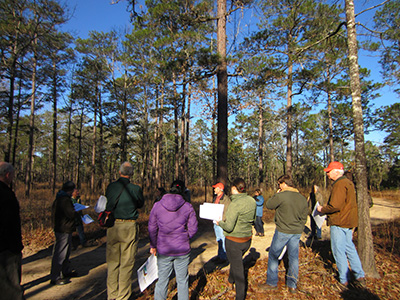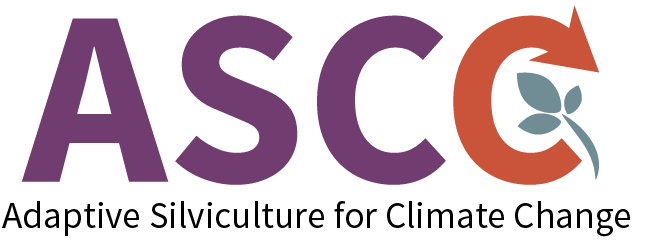Please note that we are not accepting applications for new ASCC Network sites at this time. We are focusing our capacity on launching the current cohort of ASCC sites within the Network before establishing new sites. If you want to pursue adaptation demonstrations, the Northern Institute of Applied Climate Science (NIACS) & the USDA Climate Hubs help support the creation of adaptation demonstrations. Contact us to learn more.
General Background on the ASCC Network:
Photo Credit: Maria Janowiak, NIACS
The Adaptive Silviculture for Climate Change (ASCC) project was conceived over a decade ago through a university partnership with the USDA Forest Service. Since then, we have built a large team of network collaborators. Numerous thought-leaders in climate science and forest management have been deeply engaged from the beginning, providing critical input as the project continues developing.
The strengths of the ASCC project are rooted in a common set of core criteria that makes the Network distinct from other long-term silviculture and climate-adaptive ecological research experiments. The ASCC Network uses a co-development model that engages forest managers and scientists from the beginning in the co-creation of locally-relevant climate change adaptation treatments that follows the Northern Institute of Applied Climate Science (NIACS) framework1 and utilizes the resistance-resilience-transition spectrum of adaptation approaches.
ASCC is a robust, operational research experiment! Consider these points before reaching out about joining the Network:
- Can the area be set aside to be a part of the ASCC study for ~20 years into the future?
- Who will be the key scientists and managers who co-design the treatment prescriptions, deal with implementation and monitoring of the project into the future, and assisting with the commitment to complete pre- and post-treatment data collection?
- Who is the decision authority for the site? In other words, what is the governance structure and who will have the final say in what treatments will be implemented on the ground?
- What kind of site inventory data currently exists for the site?
- Is there enough area to create 16 treatment units (20-25 acres in size) that are homogeneous enough for a 400-500 acre scientific, replicated study?
- What is the capacity of the site when it comes to implementation of the adaptation treatments (resistance, resilience, transition)?
- What is the public perception of forest management in the area, and how can the project site be used as an educational opportunity with the surrounding communities?
- What are potential political or social constraints for seed sourcing and planting future-adapted species?
If you are interested in learning more about becoming a part of the ASCC Network, contact the ASCC Project Leads.
If you have a site in mind for an ASCC project, the first thing you should do is contact the ASCC Project Leads. Engage the National ASCC Network PIs at the very beginning of the project planning process. Questions should be directed to: Linda Nagel, the ASCC Network Lead PI (linda.nagel@colostate.edu) or Courtney Peterson, the ASCC Network Coordinator (courtney.peterson@colostate.edu).
The ASCC Network may continue expanding dependent upon funding and capacity. As such, the Leadership Team is considering which forest ecosystems of concern should be given high priority for inclusion in the study. Due to limited capacity, the ASCC Project Leads will prioritize partnerships with potential new sites in these high priority locations.
To encourage broader application of these foundational climate-adaptive concepts to other forest ecosystems, and to facilitate application in places where the Core Site criteria cannot be fully met (i.e., full replication is not possible), we are exploring developing a second tier of Affiliate Sites for consideration as part of the overall project. Questions should be directed to: Linda Nagel, the ASCC Network Lead PI (linda.nagel@colostate.edu) or Courtney Peterson, the ASCC Network Coordinator (courtney.peterson@colostate.edu).
Benefits & Impacts of the ASCC Project:

Photo Credit: Molly Roske
The ASCC project directly addresses numerous barriers to implementing climate-adaptive forest management. ASCC provides managers and scientists with tools for integrating climate change considerations into their decision-making, and helps managers develop locally appropriate adaptation actions for addressing climate change. The ASCC framework provides a straightforward process and a robust, replicated, long-term study design for testing climate change adaptation strategies across a variety of forest ecosystems. It also equips managers with a practical approach to incorporating a suite of adaptation actions into silvicultural planning. Treatments and findings from this study are part of an active network of long-term silviculture research, and create a model experimental design for research on forest adaptation to climate change.
Science-management partnerships built through the ASCC project are helping to inform research and advance communication of climate change adaptation at both a local and national scale, the lack of which is often a barrier to on-the-ground application of climate change science. In this way, ASCC addresses the need for operational, tangible examples of adaptive management which field practitioners can directly apply to their own forest types to prepare for the impacts of climate change and to best manage for ecosystem adaptation into the future.
The key unique strengths of the ASCC Network are:
- The project is a true partnership between managers and researchers that is key to the co-development of adaptation strategies and approaches for each ASCC site.
- The project is mission-critical to USDA Forest Service Research and Development, and the research being conducted by the ASCC Network is not only professionally but also ethically important for maintaining forest values for future generations.
- The treatments at each ASCC site are scientifically robust and follow a replicated experimental design over the long-term that is applicable to landscape-scale contexts.
- The ASCC project framework encourages stakeholder engagement and communication, facilitates long-term dialogue and outreach to the broader management community, and is advancing the communication of climate change adaptation at a national-to-international scale.
- The ASCC Network truly puts adaptive management theory into practice through on-the-ground, local silviculture treatments.
1 Swanston, C.W., M.K. Janowiak, L.A. Brandt, et al. 2016. Forest adaptation resources: Climate change tools and approaches for land managers, 2ndedition. USDA Forest Service General Technical Report NRS-87-2, Northern Research Station, Newton Square, PA. 161p.
2 Nagel B.J. Palik, M.A. Battaglia, et al. 2017. Adaptive Silviculture for Climate Change: A National Experiment in Manager-Scientist Partnerships to Apply an Adaptation Framework. Journal of Forestry 115:167-178. http://dx.doi.org/10.5849/jof.16-039
3 Millar, C.I., N.L. Stephenson and S.L. Stephens. 2007. Climate change and forests of the future: Managing in the face of uncertainty. Ecological Applications 17(8):2145-2151.

